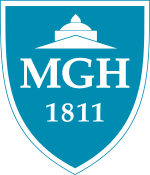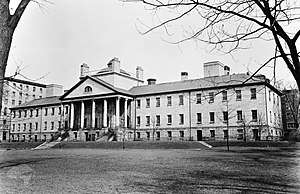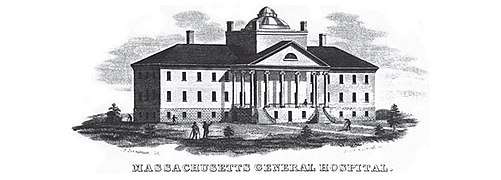Massachusetts General Hospital
| Massachusetts General Hospital | |||||||||||
|---|---|---|---|---|---|---|---|---|---|---|---|
| Partners HealthCare | |||||||||||
 | |||||||||||
 Main entrance of Massachusetts General Hospital | |||||||||||
| Geography | |||||||||||
| Location | 55 Fruit Street, Boston, Massachusetts, United States | ||||||||||
| Coordinates | 42°21′46.10″N 71°04′07.07″W / 42.3628056°N 71.0686306°WCoordinates: 42°21′46.10″N 71°04′07.07″W / 42.3628056°N 71.0686306°W | ||||||||||
| Organization | |||||||||||
| Hospital type | Teaching | ||||||||||
| Affiliated university | Harvard Medical School | ||||||||||
| Services | |||||||||||
| Emergency department | Level I Trauma Center and Level I Pediatric Trauma Center[1] | ||||||||||
| Beds | 1,034[2] | ||||||||||
| Helipads | |||||||||||
| Helipad | FAA LID: 0MA1[3] | ||||||||||
| |||||||||||
| History | |||||||||||
| Founded | 1811[4] | ||||||||||
| Links | |||||||||||
| Website |
www giving | ||||||||||
| Lists | Hospitals in Massachusetts | ||||||||||
Massachusetts General Hospital (Mass General or MGH) is the original and largest teaching hospital of Harvard Medical School and a biomedical research facility located in the West End neighborhood of Boston, Massachusetts.[5] It is the third oldest general hospital in the United States.[5] With Brigham and Women's Hospital, it is one of the two founding members of Partners HealthCare, the largest healthcare provider in Massachusetts. Massachusetts General Hospital conducts the largest hospital-based research program in the world, with an annual research budget of more than $900 million. It is currently ranked as the #4 hospital in the United States by U.S. News & World Report.[6]
In November 2017, The Boston Globe ranked MGH 5th place of top workplaces, of Massachusetts companies with over 1,000 employees, this was up from 6th place in 2016.[7]
History


The Bulfinch Building as it appeared in 1941, including the Ether Dome.
The Bulfinch Building: State of the Art from the Start.
Founded in 1811,[4] the original hospital was designed by the famous American architect Charles Bulfinch.[8] It is the third-oldest general hospital in the United States; only Pennsylvania Hospital (1751) and NewYork–Presbyterian Hospital's predecessor New York Hospital (1771) are older.[4] John Warren, Professor of Anatomy and Surgery at Harvard Medical School, spearheaded the move of the medical school to Boston. Warren's son, John Collins Warren, a graduate of the University of Edinburgh Medical School, along with James Jackson, led the efforts to start the Massachusetts General Hospital, which was initially proposed in 1810 by Rev. John Bartlett, the Chaplain of the Almshouse in Boston. Because all those who had sufficient money were cared for at home, Massachusetts General Hospital, like most hospitals that were founded in the 19th century, was intended to care for the poor.[9] During the mid-to-late 19th century, Harvard Medical School was located adjacent to Massachusetts General Hospital.
Walter J. Dodd established the radiology department at the hospital. From just after the discovery of x-rays in 1895, until his early death in 1916 from metastatic cancer caused by multiple radiation cancers he oversaw the radiology department. He also underwent over 50 surgical procedures at the hospital to treat his radiation injuries, from skin grafts to amputations.[10]
The first American hospital social workers were based in the hospital.[11]
The hospital's work with developing specialized computer software systems for medical use in the 1960s led to the development of the MUMPS programming language, which stands for "Massachusetts General Hospital Utility Multi-Programming System," an important programming language and data-base system heavily used in medical applications such as patient records and billing. A major patient database system called File Manager, which was developed by the Veterans Administration (now the Department of Veterans' Affairs), was created using this language.
Patients, families, hospital staff, and members of the public can learn more about the accomplishments MGH is most proud of at the Paul S. Russell, MD Museum of Medical History and Innovation, located at the front of the hospital's main campus on Cambridge Street.
Early use of anesthesia
It was in the Ether Dome of MGH in October 1846,[8] that a local dentist, William Thomas Green Morton, was invited to perform a public demonstration of the administration of inhaled ether to produce insensibility to pain during surgery.[8] Several years prior, Dr. Crawford Long of Danielsville, Georgia had given ether for surgery, but his work was unknown outside Georgia until he published his experience in 1849. On 16 October 1846, after administration of ether by Morton, MGH Chief of Surgery, John Collins Warren, painlessly removed a tumor from the neck of a local printer, Edward Gilbert Abbott.[8] Upon completion of the procedure, which was without screaming or restraint, the usually skeptical Warren reportedly quipped, "Gentlemen, this is no humbug." News of this "anesthesia" invention rapidly traveled within months around the world.[12]
A reenactment of the Ether Dome event was painted in 2000 by artists Warren and Lucia Prosperi. They used the then-MGH staff to pose as their counterparts from 1846.[13] The Ether Dome still exists[8] and is open to the public.
An anesthesia department was established at the MGH in 1936 under the leadership of Henry Knowles Beecher.
First successful replantation of a severed limb
On May, 1962, under the direction of Ronald A. Malt, a team of surgeons successfully accomplished the first replantation of completely severed limb.[14]
While attempting to hitch a ride on the back of a freight train, Everett Knowles hit an abutment when the train lurched, severing his arm completely at the shoulder. He and his arm were rushed to MGH, where a 30 year old Malt conducted the team of surgeons. Some doctors prepared Everett for surgery, while others worked on the separated arm. First they rejoined the "chaotically mangled blood vessels, then the bone and finally the skin." In the time since the accident, the arm had grown a "deathly gray," but grew steadily pink as the surgery progressed and blood vessels were reattached. The nerves would be reconnected in a later surgery. [15][16]
“All we did,” said the modest Dr. Malt, “was apply techniques we’ve known about for a long time and simply never had occasion to correlate before…The astonishing thing was not the newness of the operation but the teamwork—the way 12 doctors with expert skills, distinguished a collection of authorities as you could find anywhere, were willing to stand by and feed the incomparable extent of their knowledge to me, for no gain other than to know they had contributed.”[15]
Facilities and current operations
The main MGH campus is located at 55 Fruit Street in Boston, Massachusetts. It has expanded into an area formerly known as the West End, adjacent to the Charles River and Beacon Hill. The hospital handles around 1.5 million outpatient visits each year at its main campus, as well as its seven satellite facilities in Boston at Back Bay, Charlestown, Chelsea, Everett, Revere, Waltham and Danvers. With more than 25,000 employees, the hospital is the largest non-governmental employer in Boston.[17]
The hospital has 1,011 beds and admits around 50,000 patients each year.[6] The surgical staff performs over 34,000 operations yearly.[18] The obstetrics service handles over 3,800 births each year.[19] The Massachusetts General Hospital Trauma Center is the oldest and largest American College of Surgeons-verified Level One Trauma Center in New England,[20] evaluating and treating over 2600 trauma patients per year.[21] Architect Hisham N. Ashkouri, working in conjunction with Hoskins Scott Taylor and Partners, provided the space designs and schematics for the pediatrics, neonatal intensive care, and in-patient related floors, as well as the third floor surgical suites and support facilities. In the fall of 2004, the Yawkey Center for Outpatient Care (named for Jean R. Yawkey) opened. This 380,000-square-foot (35,000 m2) ten-floor facility is the largest and most comprehensive outpatient building in New England.[22] In 2011, the Lunder Building, a 530,000 square foot, 14-floor building opened. The building houses three floors of operating rooms, an expanded emergency room, radiation oncology suites, inpatient neurology and neurosurgery floors, and inpatient oncology floors; all of which increase the inpatient capacity by 150 beds.
The MGH reports it conducts the largest hospital-based research program in the United States, with an annual research budget of over $900 million in Fiscal 2017.[5] The Mass General Research Institute was launched in 2014 to serve as a front door for the hospital's research enterprise. Research at Mass General takes place in over 30 departments, centers and institutions and covers many areas including AIDS, cardiovascular research, cancer, human genetics, medical imaging, neurodegenerative disorders, regenerative medicine, transplantation biology and photomedicine.[23] The Treadwell Library, established in 1847,[24] is the health sciences library for MGH.[25]
MGH is affiliated with the Dana-Farber Cancer Institute through Dana-Farber/Partners Cancer Care and the Dana-Farber/Harvard Cancer Center.[26] They are also affiliated with Project Pinball Charity.
The closest MBTA stop to the main campus is Charles/MGH on the Red Line. On March 27, 2007, the new Charles/MGH station was opened with new renovations, including handicap accessible elevators.[27] There are five main food service areas for the general public on the MGH campus. They include the Eat Street Cafe in the lower level of the Ellison Building, the Blossom Street Cafe in the Cox lobby, Coffee Central in the White lobby, Tea Leaves and Coffee Beans in the Wang Ambulatory Care Center, and Coffee South in the Yawkey outpatient center.
The hospital offers a global second opinion service in cooperation with Grand Rounds.[28]
Affiliated institutions
Massachusetts General Hospital is affiliated with Harvard Medical School and is its original teaching hospital. Together they form an academic health science center. In February 2009, the Phillip T. and Susan M. Ragon Institute of immunology was founded to bolster research into creating vaccines and other therapies for acquired immune system conditions, chiefly AIDS. It was made possible by a $100 million gift over ten years, and represents the largest single donation made to MGH.[29] The Recovery Research Institute, created in 2013, is part of the Massachusetts General Hospital Department of Psychiatry.[30] In 2015, MGH Home Base Program became a founding partner of the Warrior Care Network heath system focused on treating posttramatic stress disorder (PTSD) in veterans, along with partners Emory Healthcare, Rush University Medical Center, UCLA Health and Wounded Warrior Project.[31][32]
Though it has its own chief of psychiatry and top ranking department, MGH is closely affiliated with nearby McLean Hospital, a psychiatric hospital also affiliated with Harvard Medical School.[33]
Awards and recognition
Nobel laureates
There have been thirteen Nobel Laureates who have either worked or trained at MGH.[34]
- 1934 George R. Minot, MD
- 1947 Carl F. Cori, PhD
- 1953 Fritz A. Lipmann, MD, PhD
- 1972 Gerald M. Edelman, MD, PhD
- 1985 Michael S. Brown, MD, and Joseph L. Goldstein, MD
- 1989 J. Michael Bishop, MD
- 1990 Joseph Edward Murray, MD & E. and Donnall Thomas, MD
- 1998 Ferid Murad, MD, PhD
- 2009 Jack W. Szostak, PhD
- 2011 Ralph Steinman, MD
- 2012 Robert Lefkowitz, MD
Rankings
In 2015, MGH was named the number one hospital in the United States by U.S. News & World Report and is nationally ranked in 16 specialties.
In 2012, MGH was named the number one hospital in the United States by U.S. News & World Report.
In 2011, MGH was named the second best hospital in the United States by U.S. News & World Report. MGH consistently ranks as one of the country's top hospitals in U.S. News & World Report.[35] In 2011, MGH was also ranked as one of the top three hospitals in the country for Diabetes & Endocrinology; Ear, Nose & Throat; Neurology & Neurosurgery; Ophthalmology; Orthopedics; and Psychiatry.
In 2003, MGH was named the state's first Magnet hospital by the American Nurses Credentialing Center, a subsidiary of the American Nurses Association. Magnet recognition represents the highest honor awarded for nursing excellence.[36]
In August 2011, Becker's Hospital Review listed MGH as number 12 on the 100 Top Grossing Hospitals in America with $5.64 billion in gross revenue.[37]
Controversies
A former MGH physician filed a lawsuit under seal in May 2015 alleging that at least five orthopedic surgeons endangered patient safety by keeping them under anesthesia longer than necessary while the surgeons performed simultaneous surgeries. Dr. Lisa Wollman refiled the lawsuit in June 2017, citing concerns that the hospital was driven by economic benefit and keeping patients unaware of the practice of concurrent surgeries. Wollman's attorney claimed that Medicare and Medicaid were being defrauded because they require that the surgeons must be present for all "critical portions" of the surgery in order to be compensated.[38]
The hospital released a statement defending the use of overlapping surgeries: "The MGH continues to believe that its practices comply with all applicable laws and regulations, and the hospital will defend the claims accordingly."[38]
Educational units
- Massachusetts General Hospital Academy
- Massachusetts General Hospital Psychiatry Academy
- MGH Institute of Health Professions[39]
See also
References
- ↑ "Verified Trauma Centers". American College of Surgeons. Retrieved 2011-09-14.
- ↑ "Massachusetts Licensed Health Care Facility/Agency Listing". Commonwealth of Massachusetts Department of Health and Human Services. Retrieved 2012-08-30.
- ↑ "AirNav: 0MA1 - Massachusetts General Hospital Heliport". Retrieved 8 July 2017.
- 1 2 3 Liz Kowalczyk (February 26, 2011). "A great institution rises and, with it, the healing arts". The Boston Globe. Retrieved 2011-02-26.
- 1 2 3 "Hospital Overview". Massachusetts General Hospital. Retrieved 25 January 2014.
- 1 2 "U.S. News Announces 2017-18 Best Hospitals". US News & World Report. Retrieved 22 March 2018.
- ↑ Johnson, Katie (2017-11-16). "Top largest employers for 2017 in Greater Boston". The Boston Globe. Retrieved 2018-10-03.
- 1 2 3 4 5 Sara Brown (February 23, 2011). "New Beacon Hill museum will showcase MGH medical innovations". The Boston Globe. Retrieved February 26, 2011.
- ↑ Harvard Medical School: A History and Background
- ↑ Suit, Herman D.; Loeffler, Jay S. (4 February 2011). "Evolution of Radiation Oncology at Massachusetts General Hospital". Springer Science & Business Media.
- ↑ Beder, J. (2006). Hospital Social Work: The interface of medicine and caring... Routlege: New York
- ↑ Fenster, J. M. (2001). Ether Day: The Strange Tale of America's Greatest Medical Discovery and the Haunted Men Who Made It. New York, NY: HarperCollins. ISBN 978-0-06-019523-6.
- ↑ Museum at Mass General Archived 2013-04-15 at Archive.is
- ↑ "Ronald Malt". The Times. 2002-11-11. ISSN 0140-0460. Retrieved 2018-06-08]. Check date values in:
|access-date=(help) - 1 2 Howard, Jane (1962). "He Takes a Grip on Life". Life Magazine.
- ↑ "Donald Alan Malt". Harvard Gazette. 2006-03-02. Retrieved 2018-06-08.
- ↑ "The Largest Employers in the City of Boston 2013". Boston Redevelopment Authority. Retrieved 10 August 2014.
- ↑ "Hospital Overview". Massachusetts General Hospital. Retrieved 10 August 2014.
- ↑ "Obstetrics Program". Massachusetts General Hospital. Retrieved 9 March 2013.
- ↑ "Hospital Overview". Massachusetts General Hospital. Retrieved 9 March 2013.
- ↑ "Division of Trauma, Emergency Surgery and Surgical Critical Care". Massachusetts General Hospital. Retrieved 9 March 2013.
- ↑ Perkins, Will. "Massachusetts General Hospital—Yawkey Center for Outpatient Care [Boston, MA]". Healthcare Design. Retrieved 9 March 2013.
- ↑ "Intensive summer program helps physicians build clinical research careers". Boston, MA: Massachusetts General Hospital. Retrieved 11 August 2014.
- ↑ Lett, Rosalind K. "Hospital Libraries". Encyclopedia of Library and Information Science (2nd ed.). p. 1208. ISBN 9780824720780.
The 1800s ushered in the establishment of several notable medical libraries: The Treadwell Library of Massachusetts General Hospital in 1847,...
- ↑ "Treadwell Library". Massachusetts General Hospital. Retrieved 14 September 2014.
- ↑ Dana-Farber Cancer Institute. "Partners and Affiliates". Retrieved 2011-09-09.
- ↑ "New Charles/MGH Station Opens". Massachusetts Bay Transportation Authority. Retrieved 10 August 2014.
- ↑ "Remote Second Opinions - Massachusetts General Hospital, Boston, MA". www.massgeneral.org. Retrieved 2017-04-24.
- ↑ "History - The Ragon Institute of MGH, MIT and Harvard". The Ragon Institute of MGH, MIT and Harvard. Retrieved 11 August 2014.
- ↑ "MGH launches Recovery Research Institute". Massachusetts General Hospital. November 8, 2013. Retrieved 1 July 2016.
- ↑ "Wounded Warrior Project announces Warrior Care Network". www.healio.com. June 8, 2015. Retrieved 2017-03-29.
- ↑ Jolie, Charlie (January 18, 2016). "Rush Launches Intensive Outpatient Program for Veterans". Rush University Medical Center. Retrieved 2017-03-29.
- ↑ "History - MGH McLean Adult Psychiatry Residency Program". Massachusetts General Hospital. Retrieved 9 March 2013.
- ↑ Massachusetts General Hospital. "MGH Nobel Prize Laureates throughout history". Retrieved 11 August 2014.
- ↑ Kotz, Deborah (17 July 2012). "Massachusetts General Hospital earns top spot in US News ranking for first time". Boston Globe. Retrieved 9 March 2013.
- ↑ "Accreditation of Continuing Nursing Education" (PDF). ANCC. Retrieved 9 March 2013.
- ↑ "Becker's Hospital Review". Becker's Healthcare. Retrieved 11 August 2014.
- 1 2 Saltzman, Jonathan; Wallack, Todd (2017-06-07). "Whistle-blower files suit over alleged double-booked surgeries". The Boston Globe. Retrieved 2017-06-08.
- ↑ MGH Institute of Health Professions
External links
| Wikimedia Commons has media related to Massachusetts General Hospital. |